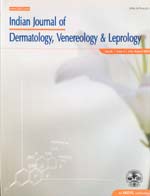
|
Indian Journal of Dermatology, Venereology and Leprology
Medknow Publications on behalf of The Indian Association of Dermatologists, Venereologists and Leprologists (IADVL)
ISSN: 0378-6323
EISSN: 0378-6323
Vol. 77, No. 6, 2012, pp. 688-694
|
 Bioline Code: dv11207
Bioline Code: dv11207
Full paper language: English
Document type: Research Article
Document available free of charge
|
|
|
Indian Journal of Dermatology, Venereology and Leprology, Vol. 77, No. 6, 2012, pp. 688-694
| en |
Oral isotretinoin in different dose regimens for acne vulgaris: A randomized comparative trial
Agarwal, Uma Shankar; Besarwal, Raj Kumar & Bhola, Kalyani
Abstract
Background: Oral isotretinoin is recommended for severe nodulocystic acne in the doses
of 1-2 mg/kg/day which is usually associated with higher incidence of adverse effects. To
reduce the incidence of side-effects and to make it more cost-effective, the lower dose
regimen of isotretinoin has been used.
Aim: To compare the efficacy and tolerability of oral
isotretinoin in daily, alternate, pulse and low-dose regimens in acne of all types and also to
assess whether it can be used for mild and moderate acne also.
Methods: One hundred
and twenty patients with acne were randomized into four different treatment regimens each
consisting of 30 patients. Group A was prescribed isotretinoin 1 mg/kg/day, Group B 1
mg/kg alternate day, Group C 1 mg/kg/day for one week/four weeks and Group D 20 mg
every alternate day for 16 weeks. Patients were further followed for eight weeks to see any
relapse. Side-effects were also recorded.
Results: Though the daily high dose treatment
Group A performed better initially at eight weeks, at the end of therapy at 16 weeks results
were comparable in Group A, B and D. Patients with severe acne did better in Group A than
in Group B, C and D. Patients with mild acne had almost similar results in all the groups
while patients with moderate acne did better in Group A, B and D. Frequency and severity
of treatment-related side-effects were significantly higher in treatment Group A as compared
to Group B, C and D.
Conclusion: We conclude that for severe acne either conventional
high doses of isotretinoin may be used or we can give conventional high dose for initial eight
weeks and later maintain on low doses. Use of isotretinoin should be considered in mild to
moderate acne also, in low doses; 20 mg, alternate day seems to be an effective and safe
treatment option in such cases.
Keywords
Acne, isotretinoin, low dose
|
| |
© Copyright 2011 Indian Journal of Dermatology, Venereology, and Leprology.
Alternative site location: http://www.ijdvl.com
|
|
